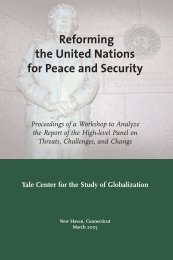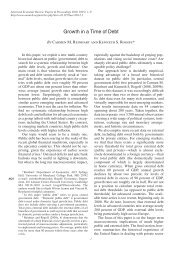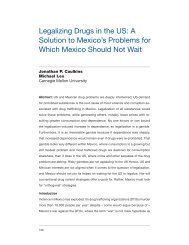The collapse of global trade, murky protectionism, and the crisis:
The collapse of global trade, murky protectionism, and the crisis:
The collapse of global trade, murky protectionism, and the crisis:
Create successful ePaper yourself
Turn your PDF publications into a flip-book with our unique Google optimized e-Paper software.
VOX<br />
Research-based policy analysis <strong>and</strong> commentary from leading economists<br />
<strong>The</strong> causes <strong>of</strong> <strong>the</strong> <strong>collapse</strong> must, <strong>of</strong> course, ultimately be centred on <strong>the</strong> financial<br />
<strong>crisis</strong> that hit <strong>the</strong> US <strong>and</strong> o<strong>the</strong>r countries. This column seeks to contribute to our<br />
underst<strong>and</strong>ing <strong>of</strong> <strong>the</strong> transmission mechanisms or channels from <strong>the</strong> <strong>crisis</strong> to <strong>the</strong><br />
synchronised <strong>trade</strong> <strong>collapse</strong>. One <strong>of</strong>ten-cited financial mechanism, for example, has<br />
been <strong>the</strong> <strong>collapse</strong> in <strong>trade</strong> credit. More broadly, tighter lending conditions worldwide<br />
have led to constraints on <strong>global</strong> spending, including spending on imports.<br />
A real transmission mechanism: Vertical specialisation<br />
However, <strong>the</strong>re is a plausible propagation mechanism coming from <strong>the</strong> nonfinancial<br />
or real side <strong>of</strong> <strong>the</strong>se economies, namely, <strong>the</strong> increased presence <strong>of</strong> vertical specialisation<br />
in international <strong>trade</strong>. Vertical specialisation occurs when goods are made in two<br />
or more sequential stages, <strong>and</strong> when at least one stage <strong>of</strong> production relies on imported<br />
inputs, <strong>and</strong> some part <strong>of</strong> that production is exported. Hummels, Ishii, <strong>and</strong> Yi<br />
(2001) <strong>and</strong> o<strong>the</strong>rs have documented that vertical specialisation – alternatively known<br />
as international fragmentation <strong>of</strong> production or international production sharing –<br />
has been increasing over time.<br />
For purposes <strong>of</strong> comparison, it is useful to first review <strong>the</strong> logic behind <strong>the</strong> st<strong>and</strong>ard<br />
international <strong>trade</strong> transmission mechanism. Suppose that <strong>the</strong> US is hit by a large<br />
negative financial shock that leads to a decline in its output. <strong>The</strong> decline in output is<br />
equivalent to a reduction in income for households <strong>and</strong> firms. <strong>The</strong>y adjust to <strong>the</strong><br />
lower income by reducing <strong>the</strong>ir spending. Some <strong>of</strong> this reduced spending is on<br />
imports. Hence, countries that export to <strong>the</strong> US suffer a reduction in exports. <strong>The</strong>se<br />
countries are now experiencing a decline in <strong>the</strong>ir output. An adjustment similar to<br />
<strong>the</strong> adjustment in <strong>the</strong> US now occurs. <strong>The</strong> adjustment eventually leads <strong>the</strong>se countries<br />
to reduce <strong>the</strong>ir spending on imports, implying that US exports decline. Hence,<br />
<strong>trade</strong> declines in both <strong>the</strong> US <strong>and</strong> its trading partners. 16 <strong>The</strong> mechanism described<br />
above hinges on <strong>the</strong> income channel. <strong>The</strong> speed <strong>of</strong> adjustment depends on how long<br />
it takes for:<br />
• <strong>the</strong> decline in US output to lead to reduced spending by US households <strong>and</strong><br />
firms,<br />
• <strong>the</strong> reduced spending by <strong>the</strong> US to lead to lower output in its trading partners,<br />
• <strong>the</strong> lower output in <strong>the</strong> US's trading partners to lead to reduced spending by<br />
<strong>the</strong>ir households <strong>and</strong> firms,<br />
• <strong>the</strong> reduced spending in <strong>the</strong> US's trading partners to lead to lower exports by <strong>the</strong><br />
US.<br />
Depending on how long it takes <strong>the</strong> income effects to be transmitted, <strong>the</strong> adjustment<br />
could take some time. Moreover, in a world in which all <strong>trade</strong> is value-added, <strong>the</strong><br />
decline in <strong>trade</strong> is exactly equal to <strong>the</strong> decline in dem<strong>and</strong> for final imported goods.<br />
<strong>The</strong> <strong>trade</strong> effects are not amplified.<br />
What is <strong>the</strong> adjustment in a world with vertical specialisation, in which goods are<br />
produced sequentially in stages across different countries? Suppose again that <strong>the</strong> US<br />
is hit by a large negative financial shock that leads to a decline in its output. Initially,<br />
<strong>the</strong> adjustment is <strong>the</strong> same as in <strong>the</strong> st<strong>and</strong>ard international <strong>trade</strong> transmission mech-<br />
16 <strong>The</strong> transmission mechanism continues, as <strong>the</strong> decline US exports represents a fur<strong>the</strong>r drop in US output,<br />
leading to a fur<strong>the</strong>r drop in US incomes <strong>and</strong> spending. However, each "round" is smaller than <strong>the</strong><br />
previous round.<br />
46





